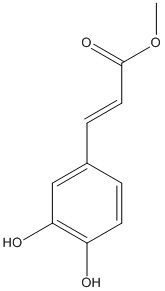Methyl-caffeate
General
Type : Acrylate || Hydroxycinnamic-ester
Chemical_Nomenclature : methyl (E)-3-(3,4-dihydroxyphenyl)prop-2-enoate
Canonical SMILES : COC(=O)C=CC1=CC(=C(C=C1)O)O
InChI : InChI=1S\/C10H10O4\/c1-14-10(13)5-3-7-2-4-8(11)9(12)6-7\/h2-6,11-12H,1H3\/b5-3+
InChIKey : OCNYGKNIVPVPPX-HWKANZROSA-N
Other name(s) : Methyl caffeate, Methylcaffeate, Methyl 3-(3,4-dihydroxyphenyl)acrylate, 3843-74-1, (E)-methyl 3-(3,4-dihydroxyphenyl)acrylate, Methyl 3,4-dihydroxycinnamate
MW : 194.18
Formula : C10H10O4
CAS_number :
PubChem :
UniChem :
Iuphar :

Target
Families : Lipase_3, Esterase_phb, Tannase, FaeC
References (4)
| Title : Fungal feruloyl esterases can catalyze release of diferulic acids from complex arabinoxylan - Lin_2023_Int.J.Biol.Macromol__123365 |
| Author(s) : Lin S , Hunt CJ , Holck J , Brask J , Krogh K , Meyer AS , Wilkens C , Agger JW |
| Ref : Int J Biol Macromol , :123365 , 2023 |
| Abstract : Lin_2023_Int.J.Biol.Macromol__123365 |
| ESTHER : Lin_2023_Int.J.Biol.Macromol__123365 |
| PubMedSearch : Lin_2023_Int.J.Biol.Macromol__123365 |
| PubMedID: 36690236 |
| Gene_locus related to this paper: humin-HiFae1 , malci-McFae1 , 9zzzz-CE1.6RZN , 9zzzz-DAC80243 , 9pezi-a0a481sy08 , aspni-FAEA , aspor-q2uh24 , aspor-q2umx6 , aspor-q2unw5 , aspor-q2up89 , neucr-faeb , magoy-l7ic25 |
| Title : Characterization of a feruloyl esterase from Aspergillus terreus facilitates the division of fungal enzymes from Carbohydrate Esterase family 1 of the carbohydrate-active enzymes (CAZy) database - Makela_2018_Microb.Biotechnol_11_869 |
| Author(s) : Makela MR , Dilokpimol A , Koskela SM , Kuuskeri J , de Vries RP , Hilden K |
| Ref : Microb Biotechnol , 11 :869 , 2018 |
| Abstract : Makela_2018_Microb.Biotechnol_11_869 |
| ESTHER : Makela_2018_Microb.Biotechnol_11_869 |
| PubMedSearch : Makela_2018_Microb.Biotechnol_11_869 |
| PubMedID: 29697197 |
| Gene_locus related to this paper: asptn-q0ci40 |
| Title : Overexpression of Aspergillus tubingensis faeA in protease-deficient Aspergillus niger enables ferulic acid production from plant material - Zwane_2014_J.Ind.Microbiol.Biotechnol_41_1027 |
| Author(s) : Zwane EN , Rose SH , van Zyl WH , Rumbold K , Viljoen-Bloom M |
| Ref : J Ind Microbiol Biotechnol , 41 :1027 , 2014 |
| Abstract : Zwane_2014_J.Ind.Microbiol.Biotechnol_41_1027 |
| ESTHER : Zwane_2014_J.Ind.Microbiol.Biotechnol_41_1027 |
| PubMedSearch : Zwane_2014_J.Ind.Microbiol.Biotechnol_41_1027 |
| PubMedID: 24664515 |
| Gene_locus related to this paper: asptu-FAEA |
| Title : Identification of a type-D feruloyl esterase from Neurospora crassa - Crepin_2004_Appl.Microbiol.Biotechnol_63_567 |
| Author(s) : Crepin VF , Faulds CB , Connerton IF |
| Ref : Applied Microbiology & Biotechnology , 63 :567 , 2004 |
| Abstract : Crepin_2004_Appl.Microbiol.Biotechnol_63_567 |
| ESTHER : Crepin_2004_Appl.Microbiol.Biotechnol_63_567 |
| PubMedSearch : Crepin_2004_Appl.Microbiol.Biotechnol_63_567 |
| PubMedID: 14595525 |
| Gene_locus related to this paper: neucr-FAED |